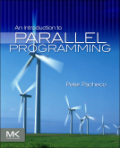
Author Peter Pacheco uses a tutorial approach to show students how to developeffective parallel programs with MPI, PThreads, and OpenMP. The first undergraduate text to directly address compiling and running parallel programs on thenew multi-core and cluster architecture, An Introduction to Parallel Programming explains how to design, debug, and evaluate the performance of distributedand shared-memory programs. User-friendly exercises teach students how to compile, run and modify example programs. Key features:Takes a tutorial approach,starting with small programming examples and building progressively to more challenging examplesFocuses on designing, debugging and evaluating the performance of distributed and shared-memory programsExplains how to develop parallel programs using MPI, Pthreads, and OpenMP programming modelsWith the coming of multicore processors and the cloud, parallel computing is most certainly not a niche area off in a corner of the computing world. Parallelism has become central to the efficient use of resources, and this new textbook by Peter Pacheco will go a long way toward introducing students early in their academic careers to both the art and practice of parallel computing. Duncan Buell Department of Computer Science and Engineering University of South Carolina An Introduction to Parallel Programming illustrates fundamental programming principles in the increasingly important area of shared memory programming using Pthreads and OpenMP and distributed memory programming using MPI. Moreimportantly, it emphasizes good programming practices by indicating potentialperformance pitfalls. These topics are presented in the context of a variety of disciplines including computer science, physics and mathematics. The chapters include numerous programming exercises that range from easy to very challenging. This is an ideal book for students or professionals looking to learn parallel programming skills or to refresh their knowledge. Leigh Little Department of Computational Science The College at Brockport, The State University of New York An Introduction to Parallel Programming is a well written, comprehensive book on the field of parallel computing. Students and practitioners alike will appreciate the relevant, up-to-date information. Peter Pacheco's very accessible writing style combined with numerous interesting examples keeps the reader's attention. In a field that races forward at a dizzying pace, this book hangs on for the wild ride covering the ins and outs of parallel hardware and software. Kathy J. Liszka Department of Computer Science University of Akron Parallel computing is the future and this book really helps introduce this complicated subject with practical and useful examples. Andrew N. Sloss FBCS Consultant Engineer, ARM Author of ARM System Developer's Guide INDICE: Why parallel computing? parallel hardware and parallel software. Distributed-memory programming with MPI. Shared-memory programming with pthreads. Shared-memory programming with OpenMP. Parallel program development. Where to go from here. References. Index.
- ISBN: 978-0-12-374260-5
- Editorial: Morgan Kaufmann
- Encuadernacion: Cartoné
- Páginas: 369
- Fecha Publicación: 15/02/2011
- Nº Volúmenes: 1
- Idioma: Inglés
